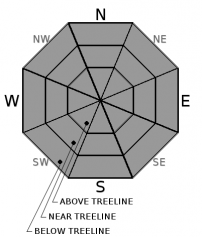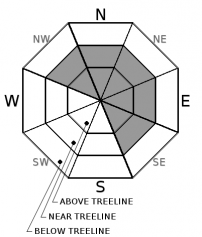| Saturday | Saturday Night | Sunday | |
|---|---|---|---|
| Weather: | Mostly cloudy skies with rain and snow in the morning. A chance of rain and snow in the afternoon. Snow level 8,000' lowering to 7,000'. | Partly cloudy skies. | Sunny skies. |
| Temperatures: | 39 to 44 deg. F. | 28 to 33 deg. F. | 46 to 51 deg. F. |
| Mid Slope Winds: | SW | SW | SW |
| Wind Speed: | 15 to 25 mph. Gusts up to 50 mph decreasing to 40 mph in the afternoon. | 10 to 15 mph with gusts to 25 mph in the evening, becoming light. | Light winds |
| Expected snowfall: | Likely up to 1 in. | Small chance 2 to 3 | 0 | 0 |
| Saturday | Saturday Night | Sunday | |
|---|---|---|---|
| Weather: | Mostly cloudy skies with rain and snow in the morning. A chance of snow in the afternoon. Snow level 8,000'. | Partly cloudy skies. | Sunny skies. |
| Temperatures: | 35 to 40 deg. F. | 28 to 33 deg. F. | 42 to 47 deg. F. |
| Ridge Top Winds: | SW | SW | SW |
| Wind Speed: | 30 to 45 mph with gusts to 85 mph, decreasing to 25 to 35 mph with gusts to 65 mph in the afternoon. | 20 to 30 mph. Gusts to 65 mph decreasing to 45 mph after midnight. | 10 to 15 mph. Gusts up to 30 mph increasing to 40 mph in the afternoon. |
| Expected snowfall: | Likely 1 to 3 in. | Small chance 4 to 6 | 0 | 0 |




























